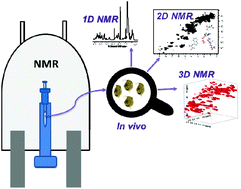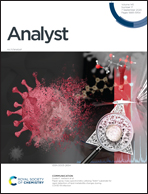NMR assignment of the in vivo daphnia magna metabolome†
Abstract
Daphnia (freshwater fleas) are among the most widely used organisms in regulatory aquatic toxicology/ecology, while their recent listing as an NIH model organism is stimulating research for understanding human diseases and processes. Daphnia are small enough to fit inside high field NMR spectrometers and can be kept alive indefinitely using flow systems that deliver food and oxygen. As such, in vivo NMR holds the potential to monitor when/if environmental stress is occurring, understand “why” chemicals are toxic (biochemical pathways impacted and toxic-mode-of-action), and differentiate between a temporary flux response (i.e. return to homeostasis) and a permanent change in biochemistry (likely a precursor to disease). At present however, such studies are limited as the in vivo NMR data of Daphnia are highly complex and the lack of spectral assignments makes extracting metabolic information difficult. In this study, Daphnia are 13C enriched to >97% 13C and numerous 1H and 13C 1D, 2D, and 3D NMR approaches are combined to provide, as complete as possible, an assignment of the Daphnia magna metabolome in vivo. Assignments are transferred (where possible) back to line narrowed susceptibility suppressed 1H 1D NMR spectra in order to permit the maximum amount of information to be gained in the future without the need for 13C enrichment. To our knowledge, this work represents the first time a comprehensive metabolic assignment of any small living organism has been performed using high field flow-based NMR.



 Please wait while we load your content...
Please wait while we load your content...